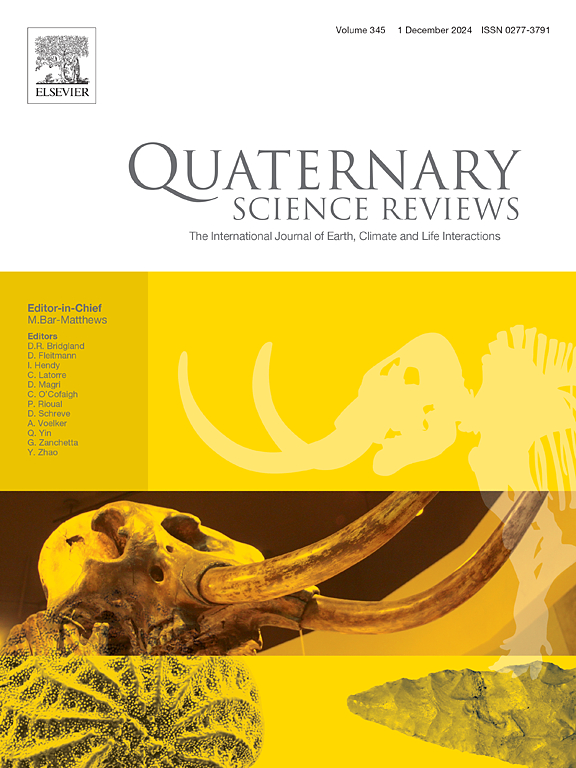中国南方Bose盆地中更新世红土矿床中的原位(飞溅状)晶岩
IF 3.3
1区 地球科学
Q1 GEOGRAPHY, PHYSICAL
引用次数: 0
摘要
澳大拉西亚tektite散落场(ATSF)是迄今为止最新和最大的确认的tektite散落场,代表了0.8 Ma左右的重大地外撞击事件(澳大拉西亚tektite event, AATE)。尽管在这一地区发现了相当数量的玻璃陨石,但大多数都缺乏明确的地层成因。这些晶岩是否可以作为早-中更新世边界附近的事件地层标志,一直是争论不休的话题。中国南部广西的Bose(或百色)盆地位于ATSF的最北端,由于与旧石器时代文物的联系,可能受到了最大的关注。在博色,在右江第四阶地(T4)的网状斑驳红粘土层中,通常保存着飞溅状的玻璃陨石,旁边还有类似阿舍利的旧石器时代石器。根据这些陨石的年龄,研究人员认为,东亚最早的手斧制造可以追溯到0.8年前。在东南亚发现的大多数晶岩都与新石器时代甚至更近的人工制品沉积物有关,而东南亚是ATSF地区晶岩分布率最高的地区。因此,学者们一直在激烈地争论玻色石英的年代是否代表了那里的阿舍利石器的实际年代。在此,我们报道了在Bose盆地大美遗址南半山地区考古发掘中出土的155块飞溅状晶陨石。顺便说一句,这是第一次在第四纪沉积物中发现如此致密的原位晶岩层。研究表明,该岩屑层主要赋存于洪泛平原沉积物的布鲁什/松山界线以下,具有明显的地层意义。这些岩屑的表面形貌、颗粒粒度分析和伴生沉积物的土壤微形态分析表明,这些岩屑具有明确的原位物源。我们的分析揭示了ATSF最北缘的一系列晶岩的形态类型。这项研究进一步强化了这样一种观点,即阿舍利类石器的生产可能是由包括中国南部在内的东南亚的直立人制造的,与最近的陨石坠落事件同时发生。本文章由计算机程序翻译,如有差异,请以英文原文为准。
In situ (splash-form) tektites from the Middle Pleistocene laterite deposits in Bose Basin, south China
The Australasian tektite strewn field (ATSF) is the most recent and largest confirmed tektite strewn field to date, representing a major extraterrestrial impact event (Australasian Tektite Event, AATE) around 0.8 Ma. Despite the fact that a considerable number of tektite locations have been discovered in this region, the majority lack a clear stratigraphic origin. Whether these tektites can serve as event-stratigraphic markers near the Early-Middle Pleistocene boundary has long been a topic of debate. The Bose (or Baise) Basin in Guangxi, southern China, is located at the northernmost edge of the ATSF and has perhaps received the greatest attention due to its association with the Paleolithic artifacts. In Bose, splash-form tektites are commonly preserved in the reticular mottled red clay layers of the fourth terrace (T4) of the Youjiang River, alongside Acheulean-like Paleolithic stone tools. Based on the age of these tektites, researchers have suggested that the earliest handaxe-making in eastern Asia could date back to 0.8 Ma. Most of the tektites found in Southeast Asia, the area of the ATSF with the highest rate of tektite distribution, are found in association with Neolithic or even more recent artifact deposits. For this reason, scholars have vigorously debated whether the age of the Bose tektite is representative of the actual age of the Acheulean stone tools from there. Here, we report on 155 splash-form tektites, unearthed during archaeological excavations at the Nanbanshan locality of the Damei site in the Bose Basin. Incidentally, this is the first time that such a dense layer of in situ tektites have been discovered in Quaternary sediments. Our study indicates that this tektite layer occurs primarily below the Brunhes/Matuyama boundary in the flood-plain sediments, showing clear stratigraphic significance. The surface morphology of these tektites, the particle-size analysis and the soil micromorphological analysis of the associated sediments together indicate that these tektites from T4 of the Bose Basin are from clear in situ provenance. Our analyses reveal a range of morphological types of tektites in the northernmost margin of the ATSF. This study further strengthens the view that the production of the Acheulean-like stone artifacts, likely made by Homo erectus in Southeast Asia including southern China, occurred simultaneously with the most recent tektite falling event.
求助全文
通过发布文献求助,成功后即可免费获取论文全文。
去求助
来源期刊

Quaternary Science Reviews
地学-地球科学综合
CiteScore
7.50
自引率
15.00%
发文量
388
审稿时长
3 months
期刊介绍:
Quaternary Science Reviews caters for all aspects of Quaternary science, and includes, for example, geology, geomorphology, geography, archaeology, soil science, palaeobotany, palaeontology, palaeoclimatology and the full range of applicable dating methods. The dividing line between what constitutes the review paper and one which contains new original data is not easy to establish, so QSR also publishes papers with new data especially if these perform a review function. All the Quaternary sciences are changing rapidly and subject to re-evaluation as the pace of discovery quickens; thus the diverse but comprehensive role of Quaternary Science Reviews keeps readers abreast of the wider issues relating to new developments in the field.
 求助内容:
求助内容: 应助结果提醒方式:
应助结果提醒方式:


